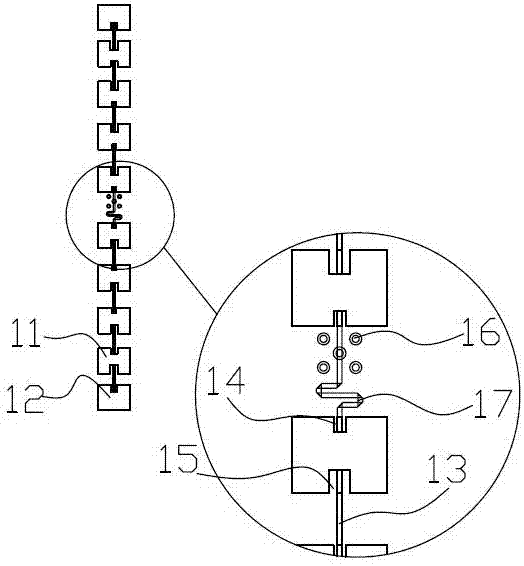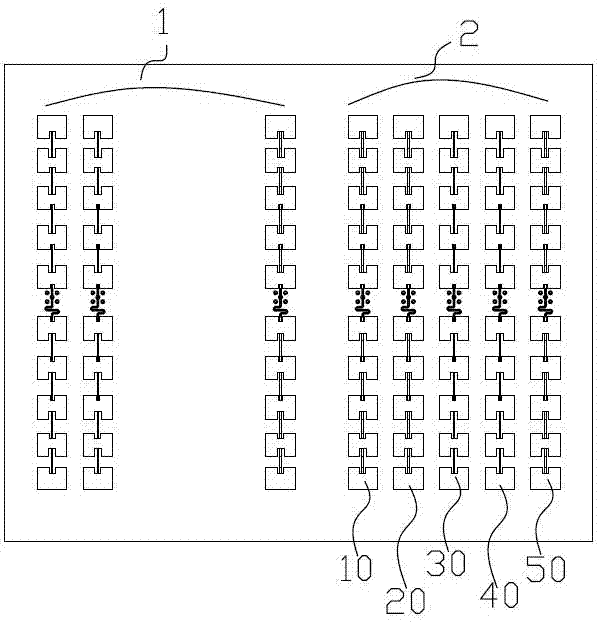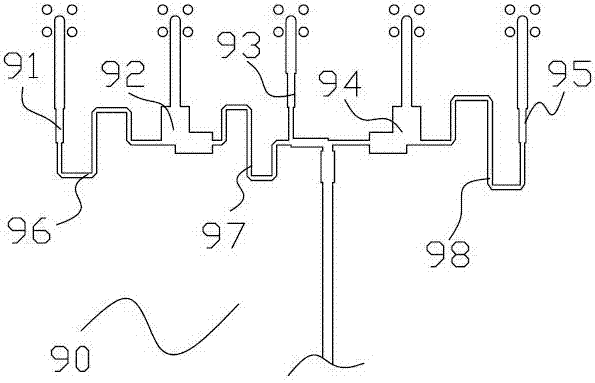Radar antenna array on rear side of automobile and antenna area array
A radar antenna and antenna array technology, applied in the field of antennas, can solve the problems of large feeder loss, low precision, narrow bandwidth, etc., to meet the needs of detection power, ensure the accuracy of angle measurement, and the effect of wide working bandwidth
- Summary
- Abstract
- Description
- Claims
- Application Information
AI Technical Summary
Problems solved by technology
Method used
Image
Examples
Embodiment 1
[0034] This embodiment provides an antenna array, which is applied to the rear side of the automobile radar and is a component of the radar antenna array on the rear side of the automobile. Since the direction detected by the radar on the rear side of the automobile has a strong directivity, the radar range The shape needs to be more precise. As the basic unit of the antenna array, it needs to have the characteristics of low sidelobe and wide bandwidth, such as figure 1 shown. It includes a plurality of first antenna units 11 and a feeding structure. Wherein, both the first antenna unit 11 and the second antenna unit 12 are square sheet structures, which may be composed of copper clad layers. In terms of arrangement, a plurality of first antenna units 11 are arranged in a line to form a line array. The feeding connection between each first antenna unit 11 is realized through a microstrip 13 . Finally, the feeding is performed through the feeding structure arranged at the c...
Embodiment 2
[0044] This embodiment also provides a radar antenna area array on the side and rear of the vehicle, which can mainly realize functions such as blind spot detection, lane change assistance, and RCTA. like figure 2 and image 3 shown. It includes a transmitting antenna unit 1 and a receiving antenna unit 2 . Specifically, it includes a plurality of in-line antenna arrays arranged on the first surface of the circuit board and a feeding network 90 arranged on the second surface of the circuit board.
[0045] Both the transmitting antenna unit 1 and the receiving antenna unit 2 are composed of a plurality of in-line antenna arrays.
[0046] In terms of the transmitting antenna part 1, it includes five in-line antenna arrays arranged in parallel, and the distance between each in-line antenna array is half of the wavelength, finally forming a transmitting antenna array.
[0047] In addition, in terms of the feeding circuit of the transmitting antenna unit 1, it is composed of c...
Embodiment 3
[0054] The difference between this embodiment and embodiment 2 is that, as figure 2 As shown, the receiving antenna unit 2 in this embodiment includes a sixth in-line antenna array 60 , a seventh in-line antenna array 70 and an eighth in-line antenna array 80 arranged in parallel. Wherein, the distance between the sixth in-line antenna array 60 and the seventh in-line antenna array 70 is 0.5 times of the working wavelength. The distance between the seventh in-line antenna array 70 and the eighth in-line antenna array 80 is 2.5 times of the working wavelength. The receiving antenna part 2 forms a 3-antenna scheme with long and short baselines to ensure accurate angle measurement with high precision.
[0055] In terms of the feeding network of the receiving antenna part 2, it is specifically fed through a separate feeding microstrip line, that is, three microstrips directly connected to the feeding source are used to feed the sixth in-line antenna array 60 and the seventh in-l...
PUM
 Login to View More
Login to View More Abstract
Description
Claims
Application Information
 Login to View More
Login to View More - R&D
- Intellectual Property
- Life Sciences
- Materials
- Tech Scout
- Unparalleled Data Quality
- Higher Quality Content
- 60% Fewer Hallucinations
Browse by: Latest US Patents, China's latest patents, Technical Efficacy Thesaurus, Application Domain, Technology Topic, Popular Technical Reports.
© 2025 PatSnap. All rights reserved.Legal|Privacy policy|Modern Slavery Act Transparency Statement|Sitemap|About US| Contact US: help@patsnap.com



